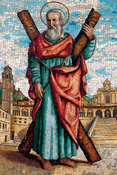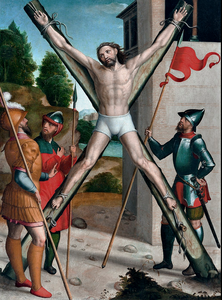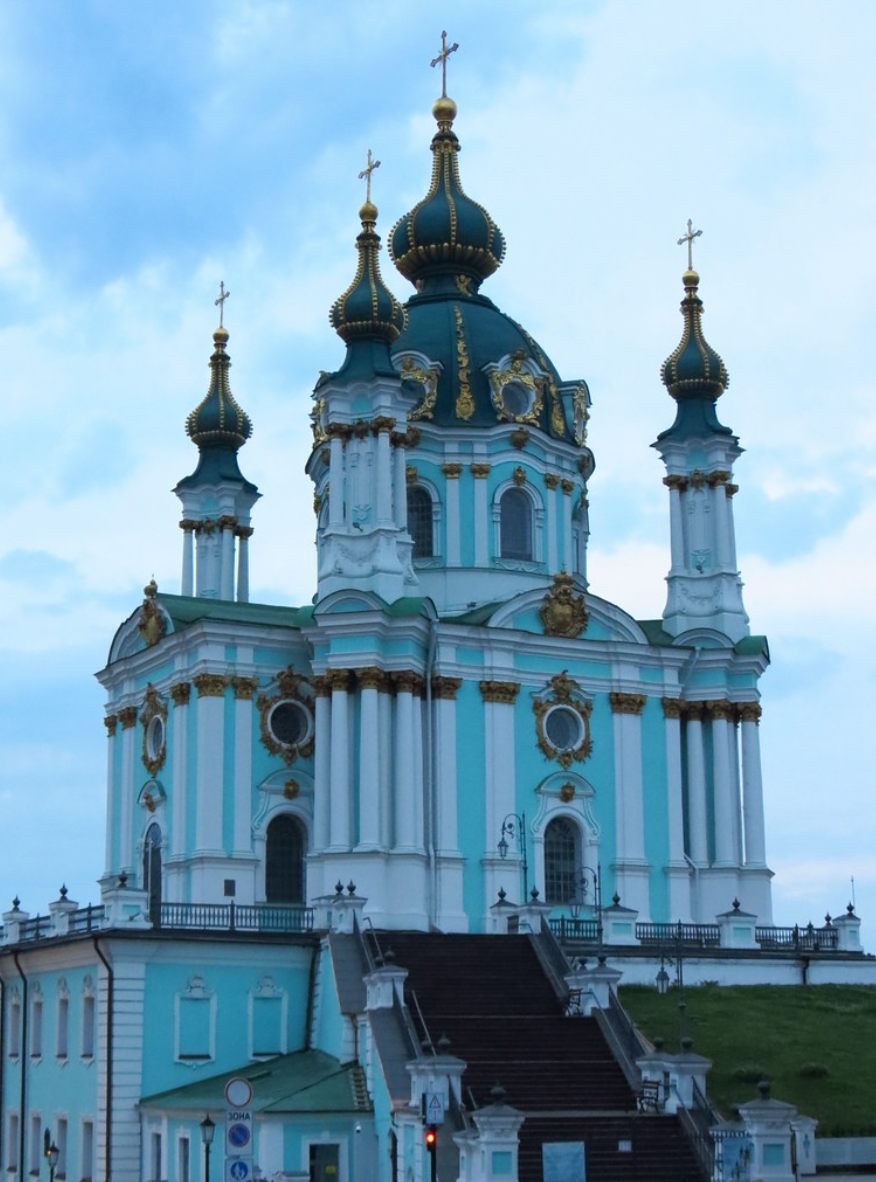 St. Andrew, the Fisherman Who Foresaw Kiev, Defeated Satan, and Saved Scotland. by Julio Gonzalez, M.D., J.D. Proudly perched atop of Andriyivskyy Descent (Andrew's Descent) in the heart of ancient Kiev, is the majestic St. Andrew's Church dedicated to Ukraine's patron saint. The church was built on the very spot where tradition holds that the Blessed Apostle Andrew placed a cross in honor of our Lord, Jesus Christ. As legend has it, Andrew climbed to the top of the hill with his disciples, which looked over the Dnieper River. Taking in the view, he placed a cross at the peak of the hill and foretold the appearance of a great city. Since then, at least three churches have been built on that spot, the present one dating back to 1744.
Andrew, along with Peter, James, and John heard Jesus prophesize of the terrible events that were to descend not only upon Israel, but personally upon the apostles:
Virtually all these prophecies applied to Andrew. After Jesus's resurrection, Andrew went east to preach the gospel (literally, "the good news"). He went to the area around the Black Sea and the Dnieper River. For a Christian this was a highly dangerous place to be since it was a land where the aggressive pagan tribes like the Rus were attempting to spread into the Roman Empire. These would have been lands and languages totally foreign to a Jew, yet Andrew somehow made his way there and successfully taught the gospel. It was as a result of his efforts of preaching the gospel in Scythia by the Dnieper River that Andrew found himself atop a hill in the wilderness of what was eventually to become Kiev and planted his cross before his disciples. Andrew also made his way to Constantinople, before it was known as such, and established the See of Byzantium, installing Stachys as its second bishop. But it was in the coastal city of Patras, in the province of Achaia (present day Greece) where St. Andrew met his greatest trial. According to the apocryphal "Acts of Andrew," there, while treating the sick and converting pagans he came across the prominent Maximilla, the interest of the proconsul or governor, Ægeates. Andrew converted Maximilla, which infuriated Ægeates, causing him to threaten the apostle with death. But again, in obedience to the warnings from Jesus, Ægeates's threats caused Andrew no fear, as he responded only by trying even more zealously to convert the proconsul, infuriating him all the more. It has been said that Ægeates possessed all the qualities of the devil, and therefore, had no chance at repentance. In his treatment of Maximilla, we see him as the seducer. In his failure to do justice, we have arrogance, and in his anger, we encounter ill temper, and selfish, unbridled passion. Yet all the temptations and threats from the devil are no match against Andrew who not only resists them, but uses them in his ascent to heaven. Andrew earnestly welcomed Ægeates's threats when the proconsul ordered his crucifixion. Like his brother Peter in Rome, Andrew refused to be nailed to the cross, finding himself to be unworthy of dying in the same manner as the Lord. Instead, he demands he be bound to the in a cross tilted diagonally, like an "X" (crux decussata). This attitude of the cross became St. Andrew's hallmark and the symbol for Scotland's flag and Russia's ensign.  On that cross Andrew preached for three days, stirring up the hearts of all who listened. Fearing a riot, Ægeates reneged on his punishment and ordered his men to take down Andrew, but the Holy Spirit interceded, literally preventing the soldier's hands from touching the apostle or the cross. Those accumulated witnessed the spectacle hastening their conversion. Finally, according to the "Acts of Andrew", "an exceeding splendor like lightning coming forth out of heaven shone down upon him and so encircled him, that in consequence of such brightness mortal eyes could not look upon him at all. And the dazzling light remained about the space of half an hour. And when he had thus spoken and glorified the Lord still more the light withdrew itself, and he gave up the ghost, and along with the brightness itself, he departed to the Lord in giving Him thanks." Maximilla witnessed the death of Andrew and helped bury him in her own tomb. Afterward, she was "united to the love of Christ, [and] spent her life blessedly with the brethren." Ægeates continued to try to seduce her with promises of wealth, but was unsuccessful. He committed suicide by "[falling] off a great height." Andrew's body remained in Patras until moved by Constantius II to the Church of the Holy Apostles in Constantinople in around 357. Legend has it, that prior to his relocation, Saint Regulus, acting under the directions received in a dream, moved some of the remains. He was later told by an angel to take them to the ends of the earth and deposit the bones wherever he would shipwreck so as to protect them from what was to come. That place happened to be Fife, Scotland. Tragically, on June 14, 1559, John Knox, the founder of the Presbyterian Church of Scotland, removed the relics of St. Andrews as part of the Protestant Reformation he was leading, and they were lost. In the thirteenth century, following the sack of Constantinople by the Turks, some of St. Andrew's relics were moved to Amalfi. Today, part of St. Andrew's small finger and skull remain in Patras along with some fragments of the cross upon which he was martyred. There are also two relics in Scotland, which were gifts from the Archbishop of Amalfi and Pope Paul VI respectively. One more connection with Scotland must be acknowledged, which is intriguing in its similarity to the experience Constantine had with Jesus in preparation for the taking of Rome. In 832, the Pictish King Óengus II (Angus) found himself preparing to do battle with an invading army of Angles led by King Aethelstan of East Anglia. Legend has it that St. Andrew appeared to Óengus II, ensuring him of his victory. In the morning of the battle, two linear clouds appeared in the shape of the crux decussata in the clear blue sky. The symbol was apparently witnessed by both sides, and inspired the Picts and Scots to victory. The symbol of a white saltire in a deep blue background was subsequently adopted as Scotland's flag. Next week we will continue our trek with Matthias, whose life, according to legend, was saved by Andrew. Help support the publication of more articles like these. Donate to The Federalist Pages, or Join The Founding Fathers Club. Read more from our Christianity Series by visiting thefederalistpages/news. Dr. Julio Gonzalez is an orthopaedic surgeon and lawyer living in Venice, Florida. He served in the Florida House of Representatives. He is the author of numerous books including The Federalist Pages, The Case for Free Market Healthcare, and Coronalessons. He is available for appearances and book signings, and can be reached through www.thefederalistpages.com.
0 Comments
Leave a Reply. |
Details
AuthorWrite something about yourself. No need to be fancy, just an overview. Archives
July 2021
Categories
All
|

 RSS Feed
RSS Feed